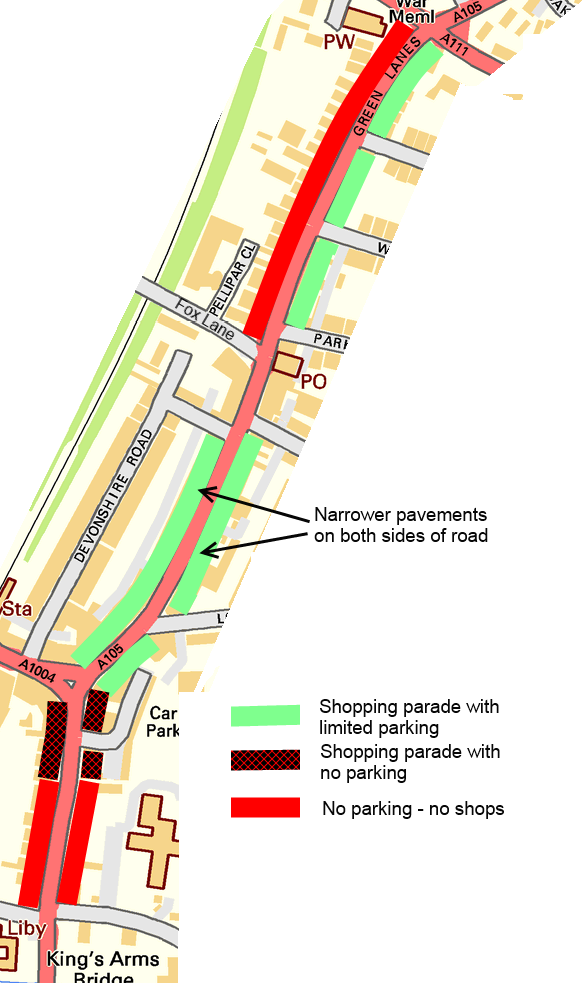"High Street parking might disappear under Mini-Holland Scheme!!!" is the headline on a leaflet issued by the Enfield Business and Retail Association (EBRA) and Green Lanes Business Association (GLBA), in which the two trade bodies warn that "It is highly likely that Pay and Display parking bays will be removed on both sides of the High Streets outside the local shops". The N21 Online website uses the lurid headline "Are our High Streets about to be Sacrificed for the Mini-Holland Superbike Highway?" But is there actually any evidence that these dire warnings have any substance?
It's certainly true that the planned creation of cycle lanes linking Enfield Town with Palmers Green via the A105 will involve reductions in the amount of on-street parking available. However, examination of documents issued by Enfield Council suggests that the planners have taken care to leave some on-street parking in the vicinity of shopping parades, certainly where Palmers Green and Winchmore Hill are concerned.

On-street parking provision in PG Town Centre based on Appendix 7 of the Mini-Holland document (not authoritative)
Section 7 of the main Mini-Holland document available on the Council website admittedly refers to using "surplus carriageway space" to provide room for cycle lanes on both sides of the road. However, this appears to refer to sections of the A105 where there is "little parking in evidence" (for instance, Village Road and Ridge Avenue). Section 7 points out that within the "high street" sections there are "higher levels of frontage activity" (council jargon for "more cars park"), so the planners clearly could not consider that there was "surplus carriageway space" along these sections.
More detail is provided in Appendix E, which comprises a section-by-section description of the proposed changes to roads, pavements and junctions along the A105. As far as Palmers Green town centre is concerned, the Appendix indicates that there would be "limited parking" alongside most of the shopping parades in Green Lanes between Hedge Lane and the Triangle, but no parking outside the short shopping parades to the south of the Triangle (see the map, which is based on my interpretation of the information in Appendix E and is not authoritative). To make room for cycle lanes in both directions along Green Lanes, rather than narrowing the area available to motorists, pavements on both sides would be narrowed and projecting bus stop pavements removed. There would be breaks in the cycle lanes at bus stops - cyclists would carry straight on when there was no bus present, or pass buses on the right.
The parts of Appendix E relating to Winchmore Hill are less clear, but certainly refer to the retention of some on-street parking:
Green Dragon Lane to Station Road:
Removal of limited parking on both sides of the carriageway. Some parking retained on northern side between Vicars Moor Lane and Sherbrook Gardens. Parking has been provided east of Firs Lane on the southern side of the carriageway as well as north of Elm Park on the eastern side of the carriageway. Where possible parking has also been provided within laybys.
Station Road to Bourne Hill:
Removal of limited parking on both sides of the carriageway. Limited parking is provided north of the junction with Queen’s Avenue on the eastern side of the carriageway.
Conclusions
The evidence suggests that Enfield Council has no intention of completely removing on-street parking in the vicinity of shopping parades along the A105. No doubt, there will be fewer parking places, but the A105 route is an essential part of the planned cycle network. Some of the additional cyclists will be shoppers. More bike journeys should mean fewer car journeys and less traffic, making Green Lanes a pleasanter environment for shoppers on foot. In any case, there is research data showing that retailers tend to overestimate the importance of car parking to their business and that the majority of shoppers in local high streets are pedestrians.
Before any of the cycling schemes can be started, Enfield Council will have to publish detailed plans and engage in real consultation with all interested parties. However, it would be helpful if they could provide some general information about the amount of parking that would be available as soon as possible, otherwise people are likely to jump to wrong conclusions.



